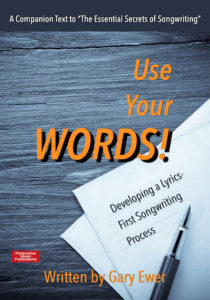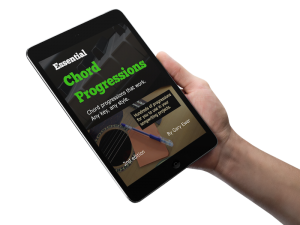It’s an important principle of all music that the energy we perceive at the end of a song should usually exceed the energy at the beginning. That increase in musical energy keeps audiences listening.
But the build in energy is not usually a straight line. It’s an ebb-and-flow quality, and it usually takes the following format:

So if you were to isolate various “identical” sections of a song — like every verse, for example — you’d notice that verse 2 typically has a bit more energy (louder and busier instruments, perhaps more backing vocals) than verse 1.
 If you’re trying to develop a lyrics-first songwriting process, but aren’t having much luck, give this ebook a read: “Use Your Words! Developing a Lyrics-First Songwriting Process.” Right now, it’s FREE with your purchase of “The Essential Secrets of Songwriting 10-eBook Bundle.”
If you’re trying to develop a lyrics-first songwriting process, but aren’t having much luck, give this ebook a read: “Use Your Words! Developing a Lyrics-First Songwriting Process.” Right now, it’s FREE with your purchase of “The Essential Secrets of Songwriting 10-eBook Bundle.”
If you want to hear how subtle these differences can be, check out Eagles’ “Life in the Fast Lane“, and the very fine, understated differences in guitar work between verse 1 and verse 2.
And then, of course, the chorus builds musical energy by bringing in backing vocals over the melody, accompanied by the distinctive 16th-note melodic motif in the guitars.
Practically every song in the pop genre does this rising and falling of song energy, and it’s important.
You may not have realized it before, but your responsibility to this up-and-down flow of energy also extends to the writing of the lyric. A lyric can sound disorganized and disconnected from the music of your song if it doesn’t also display an ebb-and-flow of energy. In the case of lyrics, it’s a kind of emotional energy, and it usually works this way:
- Verse lyrics need to describe people, situations and circumstances using conversational — and not overly emotional — words and phrases.
- Chorus lyrics need to express an emotional response to what the verse has been talking about, using emotional expressions.
- Bridge lyrics need to move quickly back and forth between a verse-like narrative style and a more emotional chorus style.
And within that general plan, you’ll notice that, just as verse 2 displays a subtle increase in musical energy over verse 1, that the second verse lyric can also tolerate (and welcome) a slightly higher emotional value.
These are the kinds of things that keep songs interesting. Not only are you using your lyric to recount a story or describe a situation or mindset, but you’re doing it in a way that partners up with the music of the song, subtly building musical energy as it goes.
If you find that your lyrics feel disconnected from the rest of the song, check to make sure that you’ve built in the ebb-and-flow of emotional energy to partner well with the musical energy of all the other song components.
 Written by Gary Ewer. Follow Gary on Twitter.
Written by Gary Ewer. Follow Gary on Twitter.
Sometimes all you need are lists of chords to get the songwriting process started. The Essential Secrets of Songwriting 10-eBook Bundle includes “Essential Chord Progressions” and “More Essential Chord Progressions.” Use the suggested chords as is, or modify them to suit your own songwriting project.











